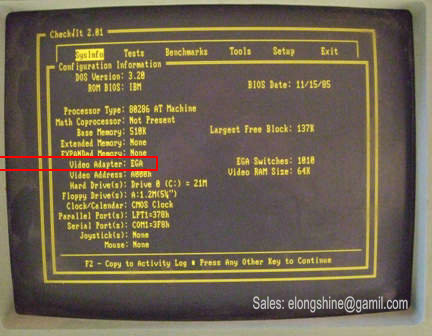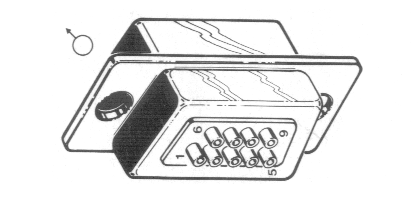The Enhanced Graphics Adapter (EGA) is the IBM PC computer display standard specification located between CGA and VGA in terms of color and space resolution. Introduced in 1984 by IBM for its new PC-AT, EGA produces a display of 16 simultaneous colors from a palette of 64 at a resolution of up to 640 × 350 pixels. The EGA card includes a 16 KB ROM to extend the system BIOS for additional graphics functions and includes the Motorola MC6845 video address generator as used in the CGA.

EGA monitor
Each of the 16 colors can be assigned a unique RGB color code via a palette mechanism in the 640 × 350 high-resolution mode; the 64 palette colors are a balanced RGB color set including all possible combinations of two bits per pixel for red, green and blue. EGA also includes full 16-color versions of the CGA 640 × 200 and 320 × 200 graphics modes; only the 16 CGA / RGBI colors are available in these modes. EGA 4-bit (16 colors) graphic modes are also notable by a sophisticated use of bit planes and mask registers together with CPU bitwise operations, which constitutes an early graphics accelerator inherited by VGA and numerous compatible hardware.
The original CGA modes are also present, though EGA is not 100% hardware compatible with CGA. EGA can drive an MDA monitor by a special setting of switches on the board; only 640 × 350 high-resolution monochrome graphics and the standard MDA text mode are available in this mode.
EGA cards use the PC ISA bus and were available starting in 8-bit versions. The base IBM EGA card came with 64 kilobytes of video memory installed, actually just enough to handle only 4 colors in high-resolution graphics (but allowing for full color in the 640 × 200 and 320 × 200 modes); expansion to 256 KB required a daughterboard. Eventually, most EGA cards and clones would come with a full 256 KB of memory. A few third-party EGA clones (notably the ATI Technologies and Paradise boards) feature a range of extended graphics modes (eg, 640 × 400, 640 × 480 and 720 × 540), as well as automatic monitor type detection, and sometimes also a special 400-line interlace mode for use on CGA monitors.
EGA Connector

9pin EGA
| Pin | Function |
| 1 | Ground |
| 2 | Secondary Red |
| 3 | Primary Red |
| 4 | Primary Green |
| 5 | Primary Blue |
| 6 | Secondary Green |
| 7 | Secondary Blue |
| 8 | Horizontal Sync |
| 9 | Vertical Sync |
EGA Signal
| Type | Digital, TTL |
| Resolution H x V | 640 x 350 other modes available |
| H-freq | 15.7 or 21.8 kHz |
| V-freq | 60 Hz |
| Colors | 6-bit (64) |

